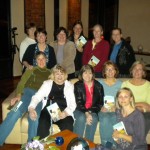Scene writing takes skill. Writers must employ the basic elements of a scene, but if the scene is not important, it may be a waste of time. Knowing when to hold ’em (onstage) and when to fold ’em (by summarizing) will propel your story into the stratosphere!
Writing Tip for Today: How can writers know which scenes are better summarized?
Scenes to Summarize (or even skip!).
Good Morning!
As I’ve said before, you can usually skip over or summarize with a sentence the things we all do every day: hearing the alarm clock, smelling coffee, showering, getting dressed, etc. UNLESS one of these actions is crucial to the story. Readers assume your character won’t go to work in his underwear. Don’t waste readers’ time with coffee sipping, newspaper reading or breakfast eating. You can safely omit these “morning” rituals.
Introductions.
If you must introduce characters, be brief. “Hi, I’m Mary.” beats “John, I’d like you to meet Mary Manners. Mary, this is John Doe.” It’s OK to shake hands, but you do not need to write, “He REACHED OUT A HAND and shook her hand.” Avoid reaching, turning and other actions and go straight to the important stuff: He shook her hand. Thus, “She TURNED her head to look at John” becomes simply, “She looked at John.” If the character has her back to the other character, you can simply say, “she turned and looked at John. We know it’s her head.
Gossip and Chit-Chat.
Some writers defend their acting out of “chit-chat” or gossip with the claim that it builds character. If you do this, give only the briefest hint of the behavior. (EX: Gert sipped her tea. “Did you know there are seventy-four varieties of this tea?”) Only if the story is about tea should you add this kind of mindless banter to a scene. The reason? Readers are always looking for clues to the story. Whatever you act out, they assume is important. Scenes where nothing happens disappoint readers who are trying to figure out which way the story is headed.






Hello, Linda. Kathleen Ruckman recommended subscribing to your blog so I could find information on scene writing. I’m currently working on a memoir with 16,000 words so far. The story outline is about two-thirds along. I understand it’ll take at least 50,000 words to make a book, so I’d like advice on creating scenes. Thank you.
Hi Nancy, and Welcome to my blog.
I’m so glad you asked about scene writing. The main difference between a scene and a non-scene or summary, is that scenes re-enact the action. As the author, you disappear and don’t “tell” the story. You use dialogue, action etc to let the characters act out the story. This is the main difference between showing (scenes) and telling (summaries). You can also use the search function for scenes here or so an online search on fiction scene writing.
Good luck and many blessings.
Keep writing,
Linda
PS: I also offer one-on-one coaching. Send me an email if you are interested.